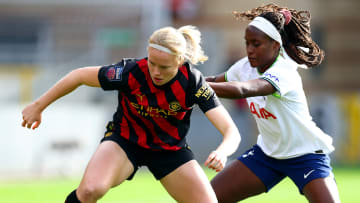MADRID — It is one of Spanish football’s most spine-tingling experiences. The stadium is filling up, fans excitedly taking their seats ahead of the game. The air buzzes with anticipation as the teams prepare to take to the pitch. Scarves are held aloft; traditional snacks like pipas (sunflower seeds,) are momentarily set aside. And from the speakers comes a sound that captures the tradition and colour of LaLiga like no other: the club himno, or anthem.
The crowd joins in, thousands of voices singing along at the top of their lungs to the crackly, decades-old recording. It’s an emotional moment, the lyrics speaking of the club’s history, its values, its identity.
– Stream on ESPN+: LaLiga, Copa del Rey, more (U.S.)
Whether it’s Real Madrid‘s “Hala Madrid” or Barcelona‘s “Cant del Barca,” Sevilla‘s “Himno del Centenario” or Valencia‘s “Amunt Valencia,” the whole stadium singing along — often a capella when the music drops out — might just be the unforgettable highlight of your football trip to Spain.
At Spotify Camp Nou on Wednesday, moments before Barcelona’s El Clasico Copa del Rey semifinal second leg with Real Madrid (stream live on ESPN+ at 3 p.m. ET) kicks off — and again at full-time — it will be the club’s “Cant del Barca” that rings out around the vast, 95,877-capacity arena. “The whole stadium cheers loudly,” the lyrics begin. And it will.
All the words to the @FCBarcelona club anthem! 💙❤🎶#ElClasico pic.twitter.com/bMrOuzSb0h
— LaLiga English (@LaLigaEN) October 28, 2018
The song sounds like it’s been around forever — perhaps since the club’s foundation in 1899 — but it isn’t as old as you might think. “The current himno is from 1974,” Carles Santacana Torres, professor of contemporary history at the University of Barcelona — and a Barca fan — tells ESPN. “It was commissioned by the then-board for the club’s 75th anniversary but it ended up becoming the club’s anthem, not just for those celebrations, but to the present day. Next year it will be 50 years old.”
The writers Josep Maria Espinas and Jaume Picas were tasked with coming up with the Catalan lyrics, while the music — after a public competition — was written by composer Manuel Valls.
“Cant del Barca” lyrics:
The whole stadium cheers loudly,
We’re the blue and maroon supporters.
No matter where we come from, be it south or north,
Now we all agree, we all agree, one flag unites us as brothers.
Blue-maroon in the wind, a valiant cry,
We have a name that everyone knows: Barca, Barca, Barca!
Players, supporters, united we all are strong.
Many years of support, we’ve cheered many goals
And we have shown, we have shown, that no-one can break us.
Blue-maroon in the wind, a valiant cry,
We have a name that everyone knows: Barca, Barca, Barca!
“They were given a lot of freedom with the lyrics,” Santacana says. “It’s a lyric that’s still valid today in 2023, but it’s also about the moment in which it was created. There’s a line which says ‘No matter where we come from, the south or the north.’
“In the Catalonia of 1974, people weren’t thinking about a global, universal club like today. It was a time when there was lots of migration from Andalusia and Castilla to Catalonia. The writers were talking about Barca as a club of social integration; a club that wasn’t just for people with generations of Catalan ancestry. It was also for those arriving in Catalonia. That was very important in that moment.”
The “Cant del Barca” was first performed by a pitchside choir at a friendly organised for the club’s 75th anniversary between Barcelona and the East Germany national team. Before long, it was a regular feature at Camp Nou.
“The board realised the impact it was having,” Santacana adds. “Barcelona had other himnos — there was one in 1910, another in 1923, and another was written when Camp Nou was inaugurated in 1957 — but they didn’t have the same popularity. By the 1970s, it was obvious that there wasn’t a song which represented the club. The himno came at the right time, it filled a void … It’s a song for all the fans. You identify with it. It refers to the union between players and fans. It’s about tradition, the goals we’ve celebrated together. You feel you’re part of a group, part of a family.”
Just as Barcelona have had several himnos throughout their history, Real Madrid have multiple club anthems too. The difference is that all three of Madrid’s remain in use to this day.
The original — “¡Hala Madrid!” or “Come on Madrid!” — was commissioned in 1952 by then-club president Santiago Bernabeu, written by composer Indalecio Cisneros and recorded by popular singer Jose de Aguilar. Its lyrics speak of a “clean, white flag that doesn’t tarnish” and a side made up of “veterans and novices” — very apt for the club’s 2022-23 midfield of Toni Kroos, Luka Modric and Eduardo Camavinga — describing the team as a “noble and warlike champion.”
Some 20 years later, Aguilar switched sides to record the anthem of Real’s rivals Atletico Madrid. Its 1974 lyrics still speak nostalgically of “going to the Manzanares [river,] to the Vicente Calderon stadium” despite Atletico’s cross-city move to the Metropolitano in 2017.
Real Madrid’s second himno, the “Himno del Centenario,” was commissioned for the club’s 100th birthday in 2002. Written by 1980s Spanish popstar Jose Maria Cano and sung by opera singer Placido Domingo it also, confusingly enough, features the repeated refrain “¡Hala Madrid!”
But why have two club anthems when you can have three? Madrid’s third was released ahead of their 10th, epic European Cup win in 2014. “Hala Madrid … y nada mas” or “Come on Madrid … and nothing more” features lyrics by journalist and writer Manuel Jabois.
The music was composed by Moroccan producer and songwriter RedOne, real name Nadir Khayat, who has an eclectic CV: he previously worked with Lady Gaga and Nicki Minaj, and now boasts the intriguing job title of “Creative Entertainment Executive” at FIFA.
“My idea was that the entire Santiago Bernabeu would come together to sing,” RedOne told El Confidencial in 2014. “I was a bit nervous to see how the fans would react. I know what I’m doing, I’ve written a lot [of songs] but the Madrid crowd is very different … When I’m at the stadium [and hear the song] I burst into tears. It’s very emotional.”
“Hala Madrid… y nada mas” lyrics:
The history you’ve made, the history you’ll make
Because no-one can resist your will to win
The stars are coming out, my old Chamartin
From far and near, you’ve brought us here
I wear your shirt close to my heart
The days that you play are everything to me
‘The Arrow’ [Alfredo Di Stefano] is running
My Madrid are on the attack
I am fight, I am beauty,
A cry that I learnt
Madrid, Madrid, Madrid, Hala Madrid,
And nothing more, and nothing more,
Hala Madrid.
The song was recorded ahead of the 2014 Champions League final in Lisbon — in which Real beat Atletico 4-1 after extra time — and released afterward, topping the Spanish charts. Its accompanying music video features the entire Madrid squad as Sergio Ramos, Karim Benzema and the rest head to the studio to take part in the song’s recording. No dress code was imposed: Modric is wearing a cardigan; manager Carlo Ancelotti sports a youthful leather jacket.
“They were all really good, but Jese, Cristiano [Ronaldo] and Carlo [Ancelotti] were sensational,” RedOne told Libero magazine, though Gareth Bale‘s appreciation of the lyrical subtleties is unclear.
All three himnos are played at the Bernabeu on matchdays, and for many younger fans, the most recent 2014 edition is the most meaningful.
Real Madrid and Barcelona might win LaLiga most seasons, but the battle for Spanish football’s finest anthem is not nearly so clear-cut. The two Seville giants, Sevilla and Real Betis, are among the contenders.
Sevilla’s “Himno del Centenario”, written by flamenco popstar El Arrebato — who appears to model his look on Jack Sparrow from the Pirates of the Caribbean films — has a case for being the most atmospheric football song, anywhere.
El Himno del Centenario.
Sit back and take it in. 😍 #WeareSevilla #NeverSurrenderhttps://t.co/DaGj6WBpAj pic.twitter.com/BlQdzXtO4V
— Sevilla FC (@SevillaFC_ENG) November 2, 2020
The himno of Sevilla’s local rivals Betis, known as “Balas de canon” or “Cannonballs,” isn’t far behind when bellowed by 60,000 fans at their Benito Villamarin stadium.
😮 This is how our anthem sounded just before the game against FC Barcelona 🙌 Goosebumps! 💚 pic.twitter.com/W4tL806kQi
— Real Betis Balompié (@RealBetis_en) January 30, 2017
In March this year, Athletic Club celebrated the 40th anniversary of their stirring club anthem, which the home fans sing to herald the team as the “pride of the Basque country” in the region’s native language before every match at Bilbao’s San Mames.
🎵 40 years ago today, the Athletic Club anthem rang out at The Cathedral for the very first time.
In the thread below we’ve translated it into English so you can understand the passion when you come to San Mames!#AthleticClub 🦁 pic.twitter.com/6mxQ8W6K3l
— Athletic Club (@Athletic_en) March 30, 2023
And Elche might be rock-bottom of LaLiga and heading for relegation with just two wins in 27 games this season, but if it’s any consolation to their long-suffering fans, their himno is one of Spain’s best.
Un himno y las gargantas de los hinchas.
Puro fútbol, puro @elchecf. #LaLiga #LaCasaDelFútbol pic.twitter.com/zS4Vwzy3Kx— Fútbol en Movistar Plus+ (@MovistarFutbol) September 11, 2022
Because while winning on the pitch is what matters, walking away from the stadium whistling a song that will be stuck inside your head for days afterward makes a victory even sweeter and a loss just a little more bearable.



